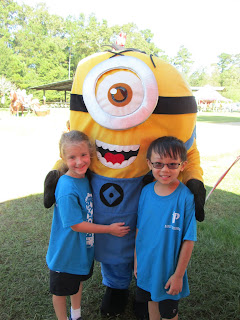 |
| Buddy Reading |
 |
| Game Station |
 |
| Reading Group |
 |
| Follow-up to Listening Station |
 |
| Journal Station |
 |
| Computer Lab- preparing for CPAA |
om
 |
| Students use the Starfall website to practice using computers. |
 |
| After a busy day of academics, it's fun to chill out on the Friendship Bench on the playground. |
|
|
|
|
Kindergartners have a short attention span, so as a teacher I have to plan a variety of activities to keep students engaged. I read somewhere that the brain likes a change of activities every 10 minutes, so few activities last longer than 15 minutes, and I spend a lot of time planning a variety of lessons, games, songs, stories, arts and crafts activities, and written assignments. Every day while I'm conducting reading groups, the students are rotating through Literacy Learning Stations such as the Listening Station, Art Station, Buddy Reading, Write the Room, Journal Station, ABC Station, and the like. With all those activities going on all around the room, it's like a three-ring circus (or maybe a five- or six-ring circus.) As I plan these activities, I'm constantly asking myself, "What are my students learning?" Is the activity reinforcing sight words? Is it giving practice with a skill we're learning, such as ABC order or identifying verbs or reading words? Is it too easy? Is it too frustrating? I'm constantly revising my plans as I get to know my students better, because even the cutest, most clever ideas are worthless if, at the end of the day, the student didn't learn anything. I can find the most adorable craft on Pinterest, and it may even go along with our theme, but if it teaches a skill that my kids mastered months ago, or if deals with a concept that's way above what we're working on, then it's a waste of time.
Student learning is assessed with standardized tests such as the CPAA, with tests that are part of our curriculum, and with individualized tests where I call students to my desk and question them one at a time. But I also look for those spontaneous sparks that occasionally fly and I hear the students say things like, "I see our sight word!" or "Come see what I wrote!" or "I can read that!" That's when I know learning is taking place, and the three-ring circus was worthwhile after all.

























































